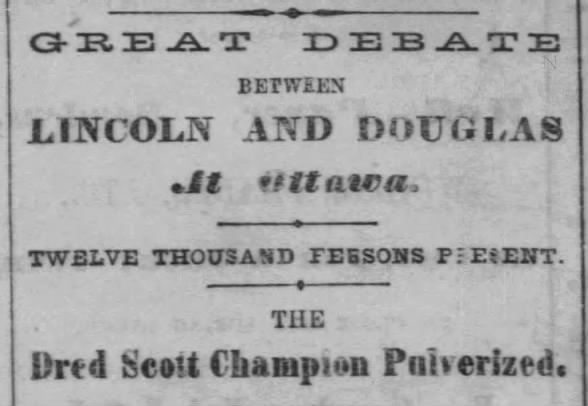Journalism, it’s often said, is the first-draft of history. That draft sometimes is found under a big headline on the front page. Other times it’s less conspicuous, perhaps on Page 6. Almanacs are full of lists of global and national historic events. But our “This Day in History” feature invites you to not just peruse a list, but to take a trip back in time to see how a significant event originally was reported in the Chicago Tribune.
Check back each day for what’s new … and old.
Princess Diana dies in a car crash — Aug. 31, 1997
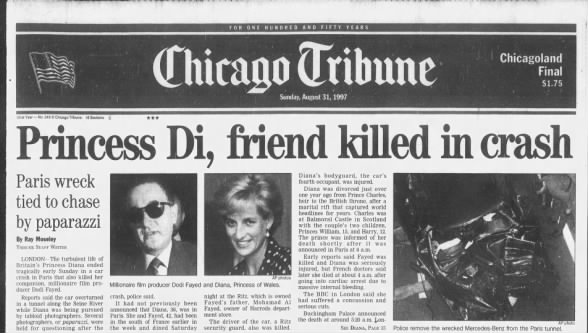
“Princess Di, friends killed in crash”
Britain’s Princess Diana, whom many around the world embraced as their own and did not let go even after she left the royal family by divorce a year earlier, was killed in a Paris car crash in the early hours of Aug. 31, 1997.
She was 36.
“The people everywhere – not just in Britain, but everywhere – kept faith with Princess Diana,” British Prime Minister Tony Blair would say. “She was the people’s princess, and that is how she will remain.”
The Mercedes-Benz in which she was riding with millionaire film producer Dodi Fayed was speeding to outrace the paparazzi photographers that dogged her to the end.
The car, traveling at 110 mph, overturned in a tunnel along the Seine River and was demolished on impact.
Fayed, 42, also was killed, as was their driver, who was found to have been well over the legal alcohol limit. Diana’s bodyguard was badly injured.
Diana and Fayed had dinner that evening at the Ritz, which his father owned.
Tribune London correspondent Ray Moseley reported it was not previously announced Diana and Fayed were in Paris. They had jetted to St. Tropez in the French Riviera on Aug. 21.
Moselely wrote: It was “their third holiday in each other’s company in five weeks. Fayed’s father said in a recent interview that the two were simply ‘young people getting to know each other.’ British newspapers reported that Diana met Fayed almost 10 years ago when he and Charles played on opposing teams.”
Part of what made Diana beloved was her charity work and advocacy on behalf of AIDS patients, against landmines, fighting cancer and raising awareness of mental health issues.
“She was a wonderful and warm human being,” Blair would observe, adding her devotion to causes showed “the depth of her compassion and her humanity.”
But there also was a sense, just below the surface, of her vulnerability.
The future princess, Diana Spencer, abruptly became an international figure at 19 in 1981 with the announcement of her engagement to Prince Charles, heir to the British throne and 12 years older. Their wedding that summer was a global TV event.
The two had a pair of sons – William in June 1982 and Harry in September 1984 – but life in the royal fishbowl was trying.
She reportedly battled bulimia and attempted suicide multiple times. Charles, meanwhile, resumed his relationship with Camilla Parker Bowles, then also married.
Ultimately, Charles and Diana divorced. It was finalized Aug. 28, 1996.
The prince would go on to marry Bowles in 2005.
An estimated worldwide audience of 2.5 billion people on Sept. 6 saw Diana’s funeral, a gathering in Westminster Abbey with a mix of powerful elite and celebrities.
It is remembered largely for friend Elton John’s performance of a reworked version of “Candle in the Wind” in her honor and brother Charles Spencer’s eulogy, a scathing indictment of the paparazzi and media he accused of making Diana “the most hunted person of the modern age.”
—
The first draft of Chicago history at your fingertips at newspapers.com.
Senate confirms Thurgood Marshall’s Supreme Court nomination — Aug. 30, 1967
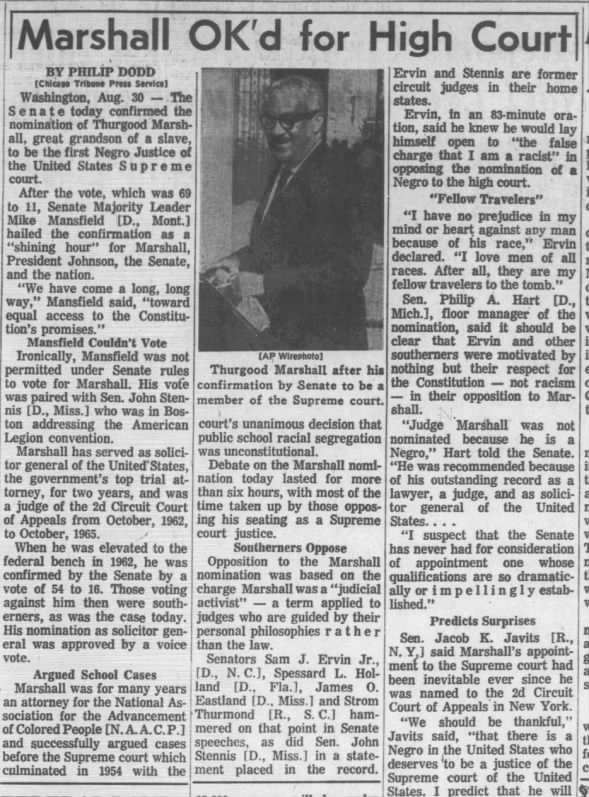
“Marshall OK’d for High Court”
Thurgood Marshall, the great-grandson of a slave, won Senate approval on Aug. 30, 1967, clearing his way to become the U.S. Supreme Court Justice’s first Black justice.
Marshall’s place in history already had been assured when, as chief counsel for the NAACP, one of the cases he successfully argued before the high court was the landmark Brown v. Board of Education, which found segregated public education unconstitutional.
President John F. Kennedy subsequently named him a federal appeals judge, and President Lyndon B. Johnson picked him to be the nation’s solicitor general before selecting him for the Supreme Court.
The Senate in ’67 confirmed him by a 69-11 vote with 20 either abstaining or voting present and, as was the case en route to the U.S. Court of Appeals for the 2nd Circuit by a 54-16 vote in 1962, the only opposition he faced was from Senators representing Southern states. (Marshall’s confirmation as the nation’s top trial attorney had been by a voice vote.)
Tribune correspondent Philip Dodd reported the stated “opposition to the Marshall nomination was based on the charge Marshall was a ‘judicial activist’ – a term applied to judges who are guided by their personal philosophies rather than the law.”
Sen. Sam Ervin (D., N.C.), one of those arguing against Marshall, said he knew he would face “the false charge that I am a racist,” but in an 83-minute speech said Marshall’s “elevation to the Supreme Court at this juncture of our history would make it virtually certain that for years to come, if not forever, the American people will be ruled by the arbitrary notions of Supreme Court justices rather than by the precepts of the Constitution.”
Ervin went on to become known for his work as chairman of the Senate Watergate Committee, presiding over nationally televised hearings that precipitated the 1974 resignation of President Richard M. Nixon.
Marshall’s 24 years on the court were marked by his staunch support of individual rights. He was anti-death penalty and pro-abortion rights.
When Marshall retired in 1991, President George H.W. Bush wound up sending another Black man to the Supreme Court as his successor: Clarence Thomas.
Hurricane Katrina hits the Gulf Coast — Aug. 29, 2005

“Katrina wallops coast”
Hurricane Katrina mercilessly slammed into the Gulf Coast on Aug. 29, 2005, ultimately leaving more than 1,200 dead and more than $100 billion worth of damage in its wake.
Tens of thousands of homes flooded in Louisiana, Alabama and Mississippi, with damage extending to other states. Millions of people were displaced and an untold number were marooned, according to Tribune correspondents Howard Witt and Dahleen Glanton.
Downtown New Orleans “escaped the worst of the hurricane,” they reported, but it was hardly unscathed.
Many sought refuge in the Louisiana Superdome, where the roof was damaged by the violent winds, allowing rain to pour in.
One of the lasting images burned into memories years later is that of survivors on their roofs, their homes islands amid the floodwaters after levees were breached, hoping to be rescued.
The National Guard rescued around 34,000 people in New Orleans. Damage to the region reportedly covered an area of more than 90,000 square miles.
Terry Ebbert, chief of homeland security for New Orleans, reflected on the tragedy of those who defied evacuation orders.
“Some of them, it was their last night on Earth,” Ebbert said. “That’s a hard way to learn a lesson.”
Another hard lesson came in the way Katrina exposed problems in the response apparatus of the nation, state and local communities. It would be years before the afflicted area was close to the same.
Amid the nearly unfathomable human toll, extensive property damage and serious ecological impact, it was years before the region was even close to the way it was before.
Cops and protesters battle in Chicago as Democratic Convention nominates Hubert Humphrey — Aug. 28, 1968

“Cops, Hippies War in Street”
While Democrats nominated Hubert Humphrey for president on the first ballot at Chicago’s International Amphitheatre, police and protesters clashed violently 41/2 miles away on Michigan Avenue on Aug. 28, 1968.
The next morning’s Tribune led with lame duck President Lyndon Johnson’s No. 2 becoming his party’s standard bearer ahead of a November loss to Richard Nixon.
“Cops, Hippies War in Street” was relegated to secondary placement.
But for those who watched the events play out on television – and for generations looking back – the rioting and response to unrest far eclipses Humphrey’s night of triumph.
“Michigan Avenue was turned into a bloody battleground last night as police swing their sticks on anti-war demonstrators and anti-Democratic Convention pickets in the streets outside the Conrad Hilton Hotel, the convention headquarters,” the Tribune reported on deadline.
“Scores were injured and thousands were affected by tear gas fired on the demonstrators by police and Illinois National Guardsmen. Scores were thrown into police vans and arrested. Late last night it was announced that more than 200 men and women had been arrested since violence erupted during the afternoon in Grant Park.”
It was not good for the Democrats, the city of Chicago or the nation.
“With George McGovern as President of the United States, we wouldn’t have to have Gestapo tactics in the streets of Chicago,” Sen. Abraham Ribicoff of New York said, nominating his South Dakota colleague, who would run unsuccessful against Nixon four years later.
Mayor Richard J. Daley responded red-faced and angrily, shouting unprintable denunciations at Ribicoff from a few rows away.
Police Supt. James Conlisk Jr., faced with criticism of his department’s tactics from delegates and others, argued that “the force that was used was the force that was necessary to repel the mob, the mob which has sought to discredit the city of Chicago and the Chicago Police Department.”
Daley told reporters Chicago’s police “are all good and decent men and they don’t respond with undue violence.”
The Tribune’s editorial page, scoffing at how “television commentators and some newspaper writers are making a fuss about the security measures,” argued they were absolutely necessary given the threat not just of “new left agitators, but the possibility they might arouse violence by black power groups.”
The editorial did not address the fact, reported a few pages earlier, that police injured at least six reporters and a Tribune photographer was arrested in the melee.
It, and subsequent editorials defending the city’s honor in fending off “the dirty, bearded, lawless rabble,” also did not account for overzealous security inside the arena.
Tribune TV writer Clay Gowran reported NBC’s Chet Huntley broke news that CBS’ Mike Wallace had been hit by a policeman on the convention floor that night.
The night before, CBS’ Dan Rather got slugged by a security person in a live on-air confrontation with “a bunch of thugs,” as Walter Cronkite referred to them.
Mayor Daley justified the strong-arm tactics, saying “the same forces creating disorder outside the hall are creating it inside.”
It was an ugly chapter for Chicago and the nation.
Ford unveils Edsel — Aug. 27, 1957
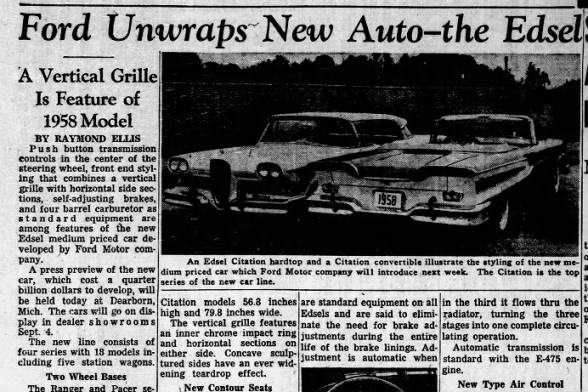
“Ford Unwraps New Auto – the Edsel”
If nothing else, the new medium-priced brand Ford Motor Co. unveiled with a big media event on Aug. 27, 1957, was unforgettable: People still talk about Edsel.
It has earned comparisons to the ill-fated maiden voyage of the Titanic and set a benchmark for New Coke decades later.
Costing a quarter-billion dollars to develop – the equivalent of $2.9 billion today – the Edsel was so hyped and so anticipated that the Tribune actually ran a story on the morning of the formal press preview later that day in Dearborn, Mich.
Ford hoped to stoke interest in the Edsel’s 1958 models arriving in dealer showrooms on Sept. 4.
But the so-called E-Day would come and go, followed by a star-studded promotional TV extravaganza 5 1/2 weeks later, starring Bing Crosby, Bob Hope, Frank Sinatra, Louis Armstrong and Rosemary Clooney – and then pffft.
Just 27 months after the big press event, Ford announced it was giving up on the Edsel. Fewer than 3,000 1960 Edsels were produced. Roughly 116,000 were sold in total, less than half the number Ford estimated it needed to break even.
There was nothing in Tribune reporter Raymond Ellis’ story to suggest what lay ahead for the brand named for Edsel Ford, who had died in 1943, four years before his entrepreneurial father, Henry.
Ellis wrote of four Edsels – Rangers, Pacers, Corsairs and Citations – available in 18 models, including five station wagons, available in 19 solid colors and 31 two-tone combinations.
Notable features included “push-button transmission controls in the center of the steering wheel, front-end styling that combines a vertical grille with horizontal side sections, self-adjusting brakes and four-barrel carburetor as standard equipment.”
They boasted lights warning of an overheating engine or low oil level, ergonomic controls and contour seats meant to reduce fatigue on long drives. For an added cost, seat belts were available.
Ford’s marketing team touted research that supposedly said there would be great demand for the Edsel. There wasn’t.
The unimpressed public rejected the Edsel as ugly and too expensive, but it remains memorable.
Krakatoa erupts — Aug. 26, 1883
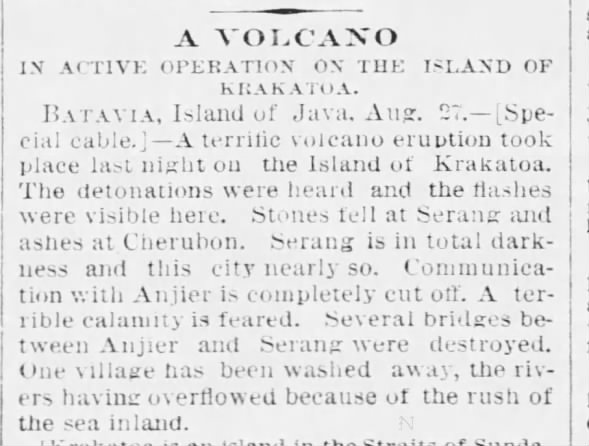
“A Volcano in Active Operation on the Island of Krakatoa”
One of the most lethal and destructive volcano eruptions in recorded history began on the island of Krakatoa on Aug. 26, 1883, its explosions and seismic effects leaving more than 36,000 dead in its wake across a wide area near where the Java Sea connects with the Indian Ocean.
The Tribune’s initial dispatch from Java’s Batavia – now known as Jakarta, Indonesia – only hints as the destruction on the other side of the strait, about 100 miles away as a bird would fly.
“A terrific volcano eruption took place last night on the Island of Krakatoa,” the report says. “The detonations were heard and the flashes were visible here. … A terrible calamity is feared.”
The full scope of that calamity could not be known yet.
More than 70% of the island and its surrounding archipelago in the Sunda Strait were destroyed.
A tsunami triggered by the seismic activity, the wave more than 130-feel tall, wiped out roughly 160 villages on the nearby shores of Sumatra and Java.
The volcano’s explosions were heard approximately 3,000 miles away in Rodrigues near Mauritius, and more than 2,000 miles away in Perth, Australia.
Ash and gases from the explosion affected global climate for some time afterward, affecting temperatures and rainfall.
They also contributed to spectacular red and orange sunsets.
Some believe Norwegian expressionist Edvard Much’s famed 1893 painting, “The Scream,” with its reddish streaks for sky, was inspired by the Krakatoa eruption.
MGM releases ‘The Wizard of Oz’ nationally — Aug. 25, 1939
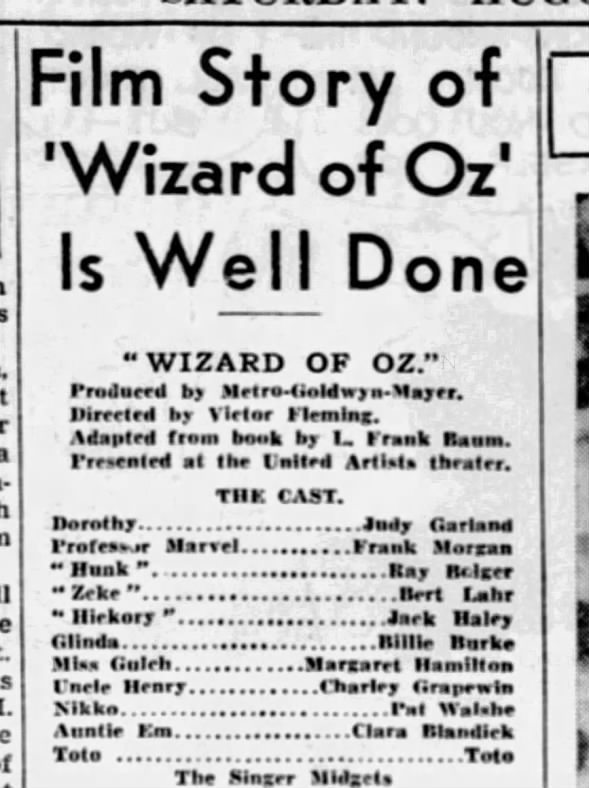
“Film Story of ‘Wizard of Oz’ is Well Done”
“The picture IS too long – no getting away from that – there’s padding in the last reels that could easily have been dispensed with,” the Tribune reviewer observed. “But, as I remember ‘The Wizard of Oz,’ this 1939 movie version of book and stage play does the old favorite pretty proud.”
Yes, the nation was off to see the wizard with Metro-Goldwyn-Mayer’s official release of “The Wizard of Oz” on Aug. 25, 1939, and the Tribune’s take was positive overall.
There had been stage and screen adaptations of L. Frank Baum’s Oz books before, but nothing quite like this one starring Judy Garland, Ray Bolger, Jack Haley, Bert Lahr and Margaret Hamilton.
It was a critical success from the start, but the film, primarily directed by Victor Fleming, didn’t become a moneymaker for MGM until its 1949 re-release. Then it became firmly entrenched in the nation’s cultural consciousness when it made its TV premiere in 1956, eventually becoming an annual television event for a time.
Never mind that most home viewers initially saw it only in black and white, thus missing out on the spectacular color scenes in its center that fairly jump off the screen.
“It is gorgeous, fantastic, radiant with technicolor,” the Tribune’s reviewer, writing under the pen name Mae Tinée (a play on “Matinee”), wrote.
“It is alive with trick photography, is jeweled with hummable tunes and features a Kansas tornado that makes you want to live anywhere but Kansas, I’m telling you.”
The review hailed Garland as perfectly cast as Dorothy.
“She portrays, without a false move, an honest to goodness little girl, genuinely flabbergasted, curious, terrified, game, lonely, ecstatic, as the case may call for,” it said. “She sings charmingly — and you’re just going to love her.”
At the 12th annual Academy Awards, six months later, “Oz” lost Best Picture and Best Art Direction to “Gone With the Wind,” which Fleming also directed. It also failed to win for Best Special Effects.
But “Somewhere Over the Rainbow,” written by Harold Arlen and Yip Harburg, won for Best Song and Herbert Stothart took home a trophy for Best Original Score.
The Academy Juvenile Award went to Garland for both “The Wizard of Oz” and “Babes in Arms.”
“Because of its many television showings between 1956 and 1974, it has been seen by more viewers than any other movie,” according to the Library of Congress.
Further endearing it to audiences is its message: “There’s no place like home.”
Baseball bans Pete Rose for life — Aug. 24, 1989

“Giamatti bans Rose for life”
Even as Baseball Commissioner A. Bartlett Giamatti handed down a lifetime suspension to Pete Rose on Aug. 24, 1989 – the penalty for betting on his team and other acts that “stained the game” – Rose expressed confidence he would be reinstated in a year.
“This poor, thick fool doesn’t even know what has just happened to him,” Tribune sports columnist Bernie Lincome wrote.
Thirty-one years later, the player and manager nicknamed Charlie Hustle – still baseball’s all-time hits leader and once considered a shoo-in for the Hall of Fame – remains on the outside looking in.
It is not as though Rose was caught unaware.
Signs warning baseball personnel of gambling prohibitions had long been on display in every clubhouse in every professional facility for decades.
They’re a legacy of the Black Sox scandal in which eight White Sox players accused of conspiring to fix the 1919 World Series they lost were legally cleared by a Cook County Court but still banished permanently from the game by Judge Kenesaw Mountain Landis, the sport’s first commissioner.
“Giamatti acted similarly, his convictions of rightness no less than those held by Landis,” Phil Hersh wrote in a front-page essay on the Rose sanction.
“Baseball can live with artificial grass made of plastic, artificial bats made of metal and artificial bodies made of steroids. It cannot live with even the possibility of artificial results made of unholy alliances between gamblers and baseball men.”
Some people then and now feel Rose was too harshly punished. On the eve of Giamatti’s decision, there had been reports he might only suspend Rose for five years.
But even if Rose only bet on his own team to win, it posed a threat to baseball’s integrity or at least raised serious questions.
To wit: Did Rose push his pitching staff when he had money on the line? What could those with whom he placed his illegal wagers surmise of the Reds’ chances in games when Rose did not put money down?
“So now Rose is out, banned from the game because he knew the rules but chose to ignore the rules,” columnist Mike Royko wrote. “Justice at its simplest.”
Giamatti, father of actors Paul and Marcus Giamatti, died of a heart attack at age 51 one week after his Rose ruling. A former president of Yale University, he had only served as commissioner five months.
Rose, who earlier in the week was on a home-shopping channel hawking autographed merchandise, keeps lobbying for reinstatement.
Ironically, now that wagering on sports has been legalized in many states, Major League Baseball and its teams today make deals with legal gambling concerns.
The restrictions on players remain firmly in place, however.
First season of TV’s ‘Survivor’ ends with a surprise — Aug. 23, 2000

“‘Survivor’ of fittest”
Richard Hatch – a nudist whose obnoxiousness was outweighed by shrewd formation of alliances – won the $1 million prize to close out the first season of the ground-breaking reality CBS TV series “Survivor” in a finale airing on Aug. 23, 2000.
The two-hour conclusion, watched at least in part by 125 million people, averaged 51.7 million U.S. viewers, per Nielsen, making it the second most watched program that year after the Super Bowl. Among series television episodes between 2000-09, its audience was right behind the 52.5 million who watched the 2004 “Friends” finale.
When “Survivor” made its debut at the end of May 2000, it was like no program before it on U.S. television, and its success inspired all manner of imitators, even reviving the long-lost genre of talent shows.
The series, hosted by Jeff Probst and shepherded by producer Mark Burnett, combined elements of practically everything else on TV, and added new ones. Hungry contestants trapped and ate wild rats at one point.
Hatch’s victory on the remote Malaysian island of Pulau Tiga, about six miles from Borneo, was something of a shocker to viewers not yet accustomed to how reality TV could be edited for maximum effect.
The scheming corporate trainer seemed doomed to lose to Kelly Wiglesworth, who managed to get immunity from being voted off just when she needed it most.
Semi-finalist Susan Hawk gave a speech at the final council fire that memorably put Hatch over the top by a 4-3 vote.
“This island is full of pretty much only two things: snakes and rats,” Hawk said. “And in the end of Mother Nature, we have Richard the snake, who knowingly went after prey; and Kelly, who turned into the rat that ran around like rats do on this island, trying to run from the snake. I believe we owe it to the island spirits we have come to know to let it end in the way that Mother Nature intended: for the snake to eat the rat.”
“So now people can finally start paying attention to that other election,” Tribune television critic Steve Johnson wrote in his front-page report. “You know, the one that will determine the next Leader of the Free World.”
Hatch apparently thought he also could out-game the Internal Revenue Service. He did not declare his “Survivor” prize money and other earnings as income and, in 2006, would be convicted of tax evasion.
Burnett settled out of court with a contestant who alleged he influenced the vote that ousted her in episode 3. He has gone on to produce such series as “The Apprentice” with Donald Trump, “The Voice,” “Shark Tank,” “Are You Smarter Than a 5th Grader?” “The Contender” and “Sarah Palin’s Alaska.”
“Survivor,” meanwhile, has continued to thrive through 40 seasons. Production for seasons 41 and 42 to air in the 2020-21 television season has been delayed by the COVID-19 pandemic.
Silkwood case settled — Aug. 22, 1986
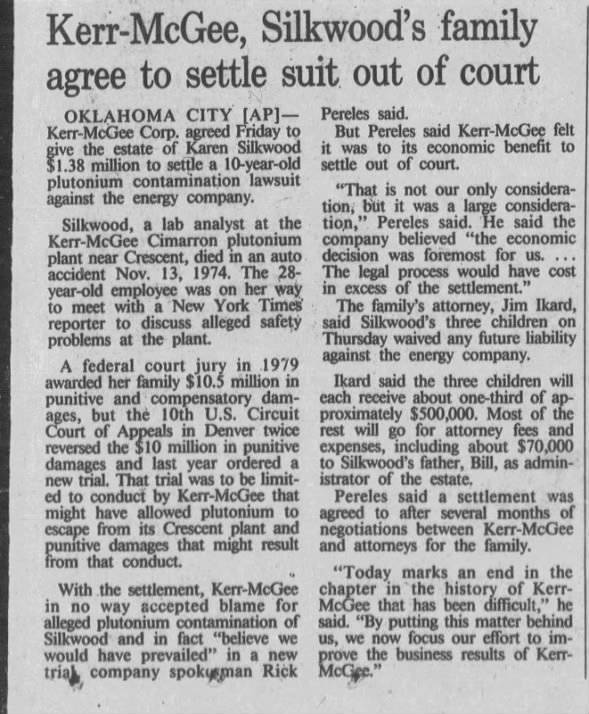
“Kerr-McGee, Silkwood’s family agree to settle out of court”
The family of the late Karen Silkwood, whose plight had been immortalized in the 1983 film “Silkwood,” agreed to a $1.38 million payment to settle its plutonium poisoning lawsuit against Kerr-McGee Corp., on Aug. 22, 1986.
Silkwood, a lab analyst at one of the energy company’s plutonium plants and labor union activist, died in a auto accident en route to a meeting with a New York Times reporter on Nov. 14, 1974. They were to discuss allegations of a safety problems at the plant.
Meryl Streep starred as Silkwood in the film, which was directed by Mike Nichols and co-written by Nora Ephron and Alice Arlen. All earned Oscar nominations as did Cher, who played Silkwood’s roommate, and the film’s editor.
Initially, in 1979, a federal court jury awarded Silkwood’s estate $10.5 million in compensatory and punitive damages. But on appeal the punitive damages of $10 million were reversed twice and, in 1985, a new trial was ordered.
Kerr-McGee did not admit culpability and said it believed it would have prevailed eventually, but the cost of continuing to fight in court would have been greater than the eventual settlement.
Silkwood’s estate waived any liability against the company.
Her three children were expected to split $500,000, with the rest of the money going to attorney fees and expenses, including $70,000 to Silkwood’s father, an estate administrator.
“Today marks an end in the chapter in the history of Kerr-McGee,” a company spokesman said. “By putting this matter behind us, we now focus on our effort to improve the business results of Kerr-McGee.”
The company was swallowed up by Anadarko Petroleum in June 2006.
First of seven Lincoln-Douglas debates — Aug. 21, 1858
“Great Debate Between Lincoln and Douglas at Ottawa”
On Aug. 21, 1858, in the first of seven debates with incumbent Stephen Douglas, U.S. Senate hopeful Abraham Lincoln asserted in Ottawa, Ill., “There is no reason in the world why the (Black man) is not entitled to all the natural rights enumerated in the Declaration of Independence.”
Said the Chicago Press and Tribune, firmly in Lincoln’s corner, “It was the opinion of every unprejudiced (listener) that Douglas would give a year off his life if he could escape meeting Lincoln at the six discussions through which he must pass.”
The debates were a proxy fight. Senators at the time were chosen by the state legislature, so the two men were campaigning on behalf of their respective parties in an effort to win control of the Illinois General Assembly.
In that, Douglas prevailed for a third term.
But how Lincoln articulated his anti-slavery views, coupled with verbatim press coverage of the debates, set the stage for his nomination and victory over Douglas and two others for the White House just two years later.
The debates themselves bore little resemblance to today’s political theater. One candidate spoke for an hour, the second got 90 minutes, followed by the first again for another 30. Lincoln and Douglas alternated who went first.
“I believe that this government was made on the white basis,” Douglas said in his opening remarks at Ottawa. “I believe it was made by white men for the benefit of white men and their posterity forever, and I am in favor of confining the citizenship to white men – men of European birth and European descent.”
What may be striking for those who have not studied the 1858 campaign is that Lincoln, while the more sympathetic of the two candidates to the plight of Black Americans, did not argue for full racial equality.
“I have no purpose to introduce political and social equality between the white and the Black races,” Lincoln said, adding that he, like Douglas, was “in favor of the race to which I belong having the superior position.”
But, he argued, the Black man still has “the right to eat the bread, without leave of anybody else, which his own hand earns” and, in that, “is my equal … and the equal of every living man.”
Targeting the “A House Divided” speech with which Lincoln earlier accepted his nomination, Douglas branded the notion all states either had to choose to allow slavery or reject it in across board “revolutionary and destructive of the existence of our government.”
Said Douglas, “Mr. Lincoln here says that our government cannot endure permanently in the same condition in which it was made by its framers.”
Lincoln responded with what today would be called a zinger.
“He has read from my speech in Springfield in which I say that ‘a house divided against itself cannot stand,'” Lincoln said. “Does the Judge say it can stand?”
The crowd laughed.
Jerry Lewis dies — Aug. 20, 2017
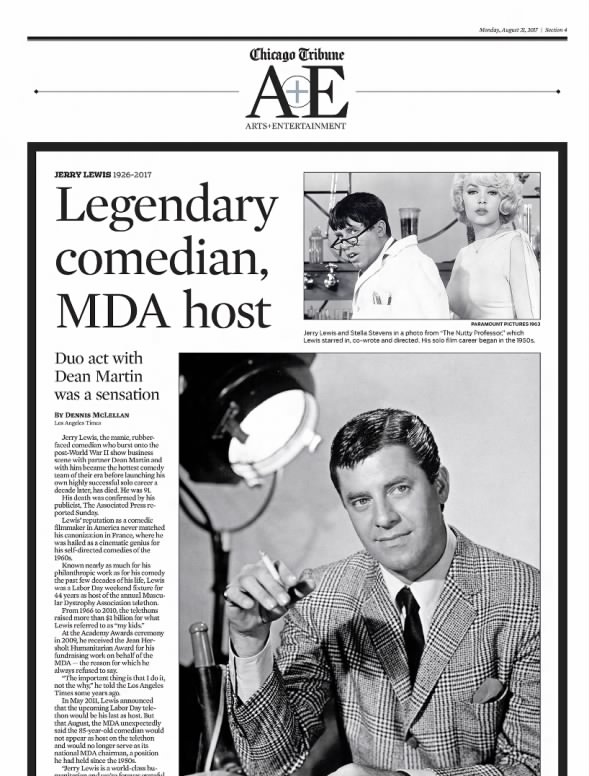
“Legendary comedian, MDA host”
Jerry Lewis was a genius who often played an idiot, a humanitarian who sometimes rubbed people the wrong way and, always, a comedian in all seriousness.
Born Joseph Levitch in Newark, N.J., Lewis died in Las Vegas at age 91 on Aug. 20, 2017, having lived a life so full it could contain his many contradictions.
His obituary in the Tribune not only noted his phenomenal popularity, how French film critics revered him and his 44-year national telethon that raised more than $1 billion for muscular dystrophy research.
It also reported Lewis was “a star many considered to have one of the biggest egos in Hollywood, a man who in later years was given to referring to himself in the third person and calling himself ‘an American icon.'”
Fans could love his work, appreciate his fundraising and still be appalled when, say, he steadfastly maintained women were incapable of being funny.
Lewis made his performing debut age of 6 with piano accompaniment from his mother. He became a household name at 20 through his stage and screen partnership with singer Dean Martin, a suave straight man to his childlike, rubbery goof.
They were the hottest comedy team of their era, perhaps ever, until they abruptly broke it off in 1956 after 10 years.
“On stage together, Martin and Lewis were known as a supercharged mix of jokes, routines, singing, dancing and, most notably, ad-libbing,” the obituary said. “The wildly unpredictable Lewis thought nothing of cutting off customers’ neckties, flinging food off their plates or setting the musicians’ sheet music on fire.”
Lewis followed with a successful solo career, which included films such as “The Bellboy,” “Cinderfella” and “The Nutty Professor.” His 1983 dramatic role as a late-night TV talk show host in Martin Scorsese’s “The King of Comedy” won him praise.
Along the way, Lewis helped Sony develop the “video assist” technology that became a movie industry standard. The advance, which enabled him to immediately review his own performances, let directors immediately see what they’ve shot without having to wait for film to be developed.
Lewis’ national Muscular Dystrophy telethon was long synonymous with Labor Day until he was unceremoniously removed by the Muscular Dystrophy Association as host and chairman just before the 2011 show. MDA never fully explained why.
Some considered the telethon mawkish, but viewers were entranced – and led to make donations – by the celebrities and acts Lewis recruited and the feature segments showing inspirational stories of those afflicted or researching a cure.
There also was the lure of the unexpected on live TV, sometimes involving a fatigued Lewis overcome with emotion.
Most memorable was in 1976, when friend Frank Sinatra surprised Lewis by reuniting him with his long-estranged comedy partner, Martin.
Groucho Marx dies — Aug. 19, 1977
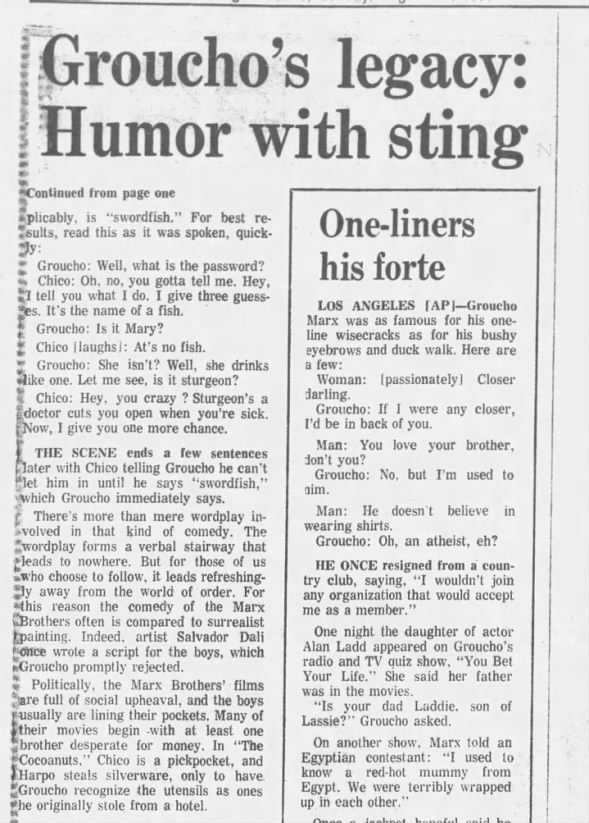
“Groucho’s legacy: Humor with a sting”
Groucho Marx, who with his brothers brought a Vaudeville and Broadway act to Hollywood and a fast-paced brand of anarchic comedy stuffed with wise-cracks and sly asides to the movies, died on Aug. 19, 1977.
Julius Marx was 86, but the brothers’ black-and-white films are ageless, though perhaps his leering persona comes in for a reappraisal today.
The jokes in his movies, on stage, books and on TV as host of the putative game show “You Bet Your Life,” were unforgettable.
A sampling:
-“You know you haven’t stopped talking since I came here? You must have been vaccinated with a phonograph needle.”
-“I find television very educating. Every time somebody turns on the set, I go into the other room and read a book.”
-“I’ve got a good mind to join a club and beat you over the head with it.”
-“I never forget a face. But in your case, I’ll be glad to make an exception.”
-“He may look like an idiot and talk like an idiot, but don’t let that fool you. He really is an idiot.”
-“I don’t want to belong to any club that would have me as a member.”
“What was special about” the Marx Brothers’ comedy, Tribune movie critic Gene Siskel wrote, “was the moment when their dialogue came so fast and furious – the puns and misunderstandings so rapid – that the viewer’s head spun out of the world of everyday logic. Nothing makes sense in the Marx Brothers’ world, except that you’re laughing.”
The names of Groucho’s characters changed – Capt. Geoffrey T. Spalding, Rufus T. Firefly and Otis B. Driftwood, to name a few – but he always was a troublemaker who insinuated himself into or near positions of authority only to upend the establishment.
At the end of his life, old age and infirmity had taken from the star his many gifts.
Marx found himself ensnarled in a sad tug of war between his family and Erin Fleming, a companion 58 years his junior. The courts would name his grandson conservator and sided with the family in the subsequent fight over his estate.
It was a sad turn for a man who always seemed in control of any situation even as he turned that situation upside down.
As his Prof. Quincy Adams Wagstaff sang in 1932’s “Horse Feathers,” effectively summing up a motif of Marx Brothers comedy: “I don’t know what they have to say. It makes no difference anyway. Whatever it is, I’m against it! No matter what it is or who commenced it. I’m against it!”
Tennessee ratifies 19th amendment ensuring women get to vote — Aug. 18, 1920

“Women’s Victory Needs One More Step”
Tennessee’s House of Representatives, by the narrowest of margins on Aug. 18, 1920, made it the 36th state to approve what would become the 19th amendment to the U.S. Constitution, effectively giving women the same right to vote as men across the nation after a decades-long fight.
“Women screamed at the top of their voices, scores placed their arms around the necks nearest them and danced, so far as it was possible to do so, in the lass of humanity,” the Tribune reported. “Hundreds of suffrage banners were waved wildly and many removed the yellow flowers they had been wearing and threw them upward to meet a similar shower from the galleries.”
The state action still had to be certified by U.S. Secretary of State Bainbridge Colby for formal ratification, which occurred eight days later despite a campaign by suffrage opponents that would continue to push for a reversal well into the next month.
But it was the lower house of Tennessee – which needed 50 votes for passage – that put the amendment over the top, 50-46, with three representatives absent. The state Senate had voted 25-4 in favor five days earlier.
Political experts, the Tribune said, estimated the nearly 27 million women in the United States of legal age and qualified to vote would complement the 29 million male voters to create a new total electrorate of 56 million.
There would remain obstacles and resistance to women voters, as all once-disenfranchised groups face, but the 19th amendment was unambiguous: “The right of citizens of the United States to vote shall not be denied or abridged by the United States or by any State on account of sex. Congress shall have power to enforce this article by appropriate legislation.”
Illinois, which in June 1919 had been the sixth state to approve the amendment, already was making preparations to allow women to vote in its Sept. 15 primaries as well as the November general election in anticipation of Colby’s certification.
“Are (women) going to join the army of kid-gloved men slackers whom I have heard proudly boast that they would not touch politics with a 10-foot pole?” asked Carrie Chapman Catt, president of the National American Women Suffrage Association. “Or are they going to be of those who will help swell America’s army of voters, who put conscience and thought into the scales with party politics and party candidates?”
A founder of both the International Woman Suffrage Alliance and the League of Women Voters, Catt has had her legacy damaged badly by racist views she espoused for many years.
Yet, when Tennessee all but made women’s suffrage the law of the land, the Tribune reported Catt “urged the women to oppose intolerance,” which she said “will cause the crumbling of any foundation.”
President Clinton admits affair — Aug. 17, 1998

“Clinton admits ‘personal failure,’ assails probe of his private life”
Seven months to the day after a sworn statement in which he asserted he “never had sexual relations with Monica Lewinsky,” President Bill Clinton testified for four hours before a federal grand jury and told the nation his earlier stance was misleading on Aug. 17, 1998.
It was the first time a sitting U.S. president had testified before a grand jury of which he was a target and edged Clinton closer to impeachment proceedings that would begin in December and end with his acquittal in February.
But just as extraordinary was the live, five-minute nationally televised address from the White House’s Map Room in which Clinton copped to an inappropriate relationship with one-time intern Lewinsky, while stressing he never urged anyone to lie or obstruct justice.
“Indeed, I did have a relationship with Ms. Lewinsky that was not appropriate,” Clinton said. “In fact, it was wrong. It constituted a critical lapse in judgment and a personal failure on my part for which I am solely and completely responsible.”
Some people would take issue with Clinton’s characterization of his earlier testimony concerning Lewinsky as “legally accurate.”
Tribune correspondent Roger Simon wrote that Clinton’s lawyers were prepared to argue, however, “that oral sex does not meet the definition of ‘sexual relations’ that Clinton was given by lawyers that day.”
Clinton, in his TV address, nevertheless conceded that his public comments and silence on salient details “gave a false impression. I misled people, even my wife. I deeply regret that.”
The President nevertheless was defiant in branding the legal actions he faced as “politically inspired,” and had “gone on too long, cost too much and hurt too many people.”
Clinton said his indiscretions were a family matter “between me, the two people I love most – my wife and our daughter – and our God.”
But, obviously, the public, the Senate and ultimately history all would have their say.
Elvis Presley dies — Aug. 16, 1977
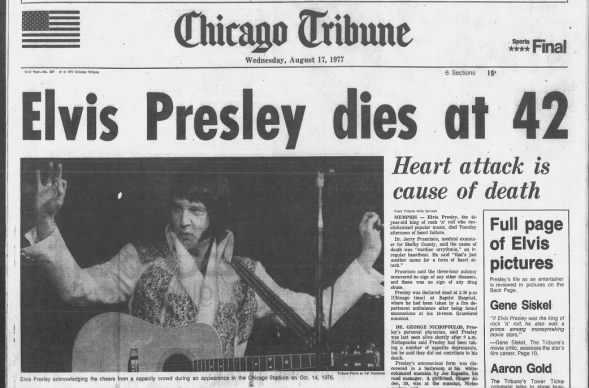
“Elvis Presley dies at 42”
Elvis Aron Presley, who for millions embodied the sexy, energetic, magnetic pull of early rock ‘n’ roll in the 1950s and then had his life become a cautionary tale of American excess, died Aug. 16, 1977, at his Graceland estate in Memphis.
He was 42.
Presley burst into the pop culture scene, a lean, young and hungry hip-shaking, sneering, seductive presence who helping to bring a synthesis of Black rhythm and blues to mainstream USA, rattling the status quo and thrilling the young.
He would become not just a musical sensation, but his TV appearances were events and for a time he was a leading man in movies. Could he act? Not really. Did he have a screen presence? Absolutely.
On whatever sort of stage he appeared, even in his later years when he had become something of an outsized caricature, he was unquestionably a star.
Alas, by the end, he would pay dearly for having surrounded himself with parasites largely guided by self-interest, either unable or uninterested in saving an increasingly isolated Presley from the indulgences that killed him.
Ginger Alden, Presley’s 20-year-old girlfriend, found him unconscious and face down in the master bathroom on the second floor of the estate he initially bought for his mother.
The Tribune’s story said that according to Dr. Jerry Francisco, medical examiner for Tennessee’s Shelby County, Presley’s death was due to an irregular heartbeat and “the three-hour autopsy uncovered no signs of any other diseases, and there was no sign of any drug abuse.”
But this was a lie, a sop to the Presley family. It turned out the other two doctors who worked on post mortem found evidence of diabetes, glaucoma and severe, chronic constipation.
A subsequent toxicology report found “significant” levels of codeine, Ethinamate and Quaaludes, along with some morphine, Demerol, Placidyl, Valium and Chlorpheniramine.
Dr. George Nichopoulous, who’s quoted in the original Tribune report as saying the appetite suppressants he prescribed Presley weren’t a factor in the singer’s death, would lose his license for overprescribing to numerous patients.
The Tribune’s front page teased details from “Elvis: What Happened?,” then a soon-to-be published tell-all by former members of Presley’s entourage who demythologized him. Among the lasting memories with which it left fans: They told of a pill-popping, delusional recluse who once, while eating breakfast, fired a gun at a TV set showing Robert Goulet performing on it.
And yet despite all of that – or perhaps because of how his poverty-to-penthouse American dream life turned into an American tragedy – Presley remains an enduring figure all these years later.
The Panama Canal opens — Aug. 15, 1914
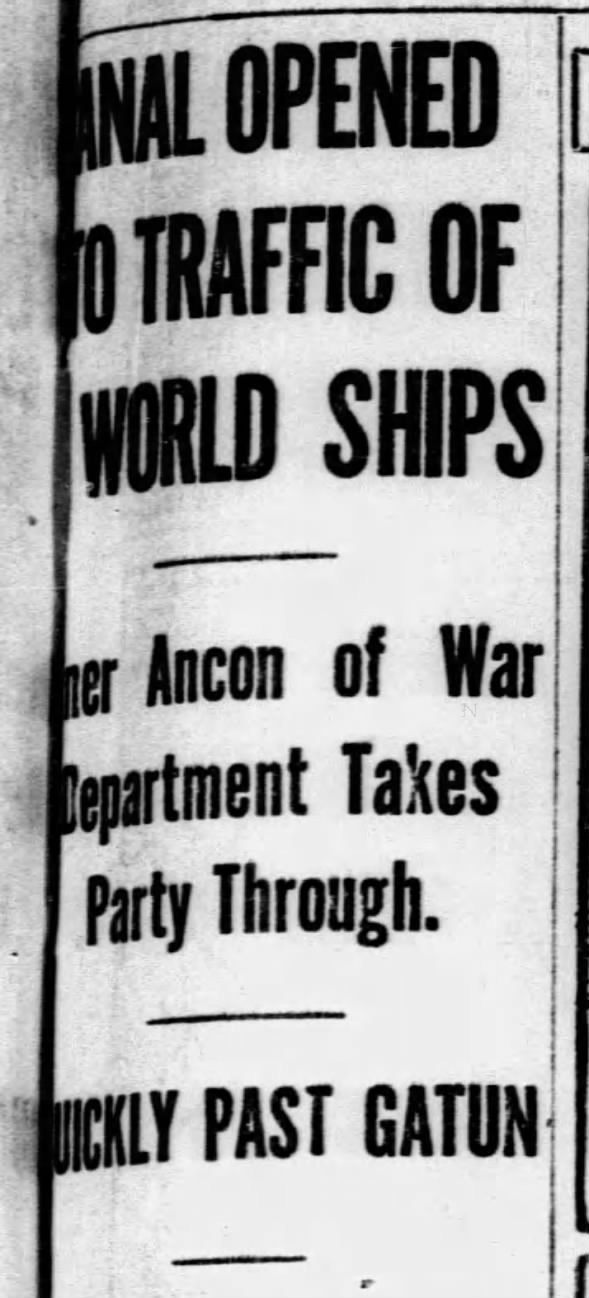
“Canal Opened to Traffic of World Ships”
A 400-year-old dream was realized when the steamship Ancon became the first commercial vessel to travel from the Atlantic Ocean to the Pacific through the Panama Canal on Aug. 15, 1914.
The Tribune’s report notes Spanish explorer Vasco Núñez de Balboa’s crossing of the isthmus on Sept. 25, 1513, first raised the possibility of a shortcut trimming thousands of nautical miles from a trip around South America’s Cape Horn.
It was, however, far easier imagined than done as Spain, Great Britain and France all found.
After France’s failed effort in the late 1800s, the United States purchased that nation’s canal zone assets but was able to use only some of the earlier excavation when it resumed work in 1904. The project would cost many millions of dollars and many lives.
Completing the canal required not only overcoming the engineering challenges and tropical diseases that had thwarted the French, but also local politics.
Panama had been a Colombian province. When an arrangement concerning the canal could not be reached, the United States employed “gunboat diplomacy” to back Panamanian independence.
One bit of trivia connected to canal construction: When Theodore Roosevelt traveled to Panama to inspect the project in November 1906, it was the first time a sitting U.S. President ventured outside the country.
Counterintuitively, a ship crossing from the Atlantic Ocean (actually the Caribbean Sea) to the Pacific (in the Gulf of Panama) does not go on an east-to-west course. Instead it travels south, then more or less east and southeast.
For years, Panama chafed at U.S. control of the canal zone, but President Jimmy Carter in 1977 signed an agreement giving the host nation an increased role in operations, culminating in complete U.S. withdrawal on Dec. 31, 1999.
While the Ancon was the first commercial vessel to use the canal, a French crane ship known as the Alexandre La Valley actually was the first to travel its length eight months earlier.
The planned celebration that would have accompanied the Ancon’s crossing was largely scrapped owing to the start of World War I just weeks earlier.
Social Security becomes law — Aug. 14, 1935

“President Puts Signature on Security Bill”
“If the Senate and House of Representatives in this long and arduous session had done nothing more than pass this bill, the session would be regarded as historic for all time,” President Franklin Delano Roosevelt said as he signed Social Security into existence on August 14, 1935.
The Tribune, famously anti-FDR, put “historic” in quotes in the lede of its coverage on page 6, talking up the cameras and lighting brought in to record the ceremony.
“From the sound screens of the country, the words will make an appeal to the unemployed and aged voters in the 1936 campaign,” the Trib said.
But 85 years later, nearly everyone in this country has a nine-digit Social Security number and there’s little doubt Roosevelt was right about the hallmark program.
“Today a hope of many years’ standing is in large part fulfilled,” Roosevelt said. “The civilization of the last hundred years, with its startling industrial changes, has tended more and more to make life insecure. Young people have come to wonder what would be their lot when they came to old age. The man with a job has wondered how long the job would last.
“This Social Security measure gives at least some protection to 30 million of our citizens who will reap direct benefits through unemployment compensation, through old age pensions and through increased services for the protection of children and the prevention of ill health.”
The first recipient of an old-age monthly benefit check through the program was Ida M. Fuller, who paid into the program between 1937 and ’39 and was paid $22.54 on Jan. 31, 1940. By 1975, when she died at age 100, she had amassed nearly $23,000 in benefits.
Over time, the benefits of Social Security would evolve, helping it endure and become an ever-more entrenched part of American life, supporting this country, its workers and their families despite concerns about its sustainability.
President Ronald Reagan, on its 50th anniversary in 1985, said the program “has proven to be one of the most successful and popular programs ever established by the Federal Government,” and noted nearly every American benefits in some way from the program.
“It provides a solid foundation of economic security upon which workers can add private pensions, savings and insurance to assure their financial well-being in retirement, or when they are unable to work,” Reagan said. “Through Medicare, it also helps elderly and disabled individuals to meet the costs of medical care.”
There may have been lights and cameras to record the moment it became law, but Social Security was more than an act of political showmanship. It was indeed historic.
Julia Child dies at 91 — Aug. 13, 2004
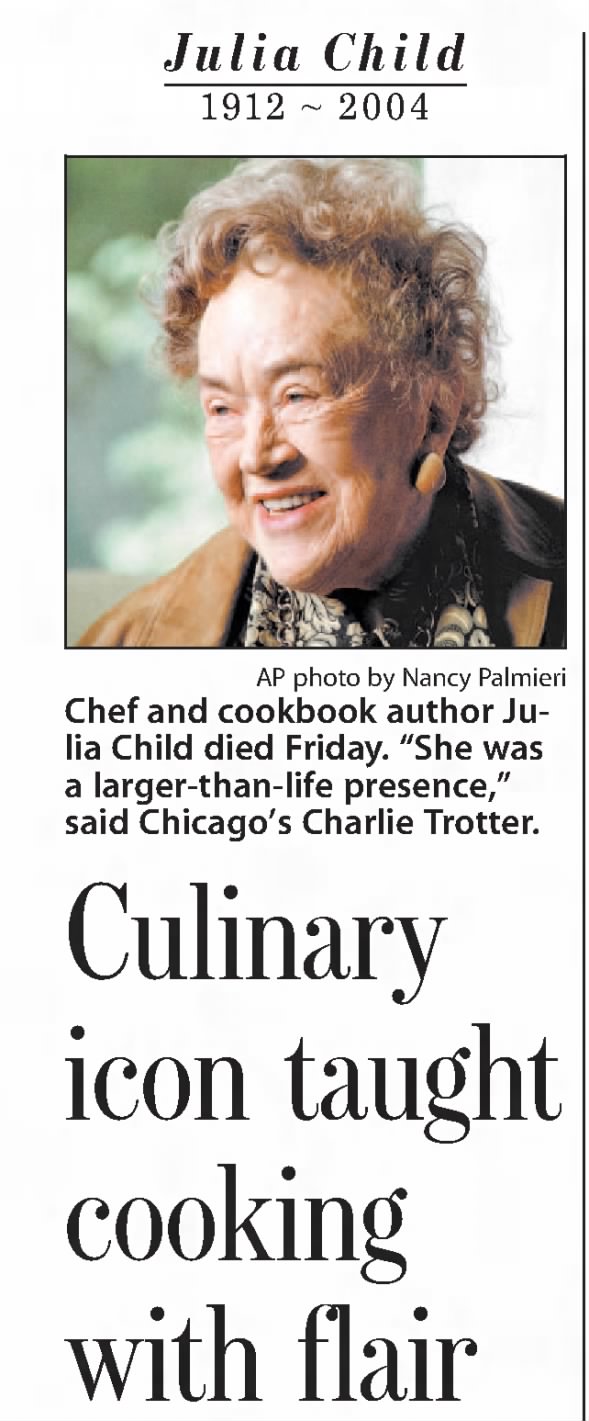
“Culinary icon taught cooking with flair”
Julia Child, who introduced millions to the global portal that their kitchen could be through her cookbooks, television shows and infectious enthusiasm, died on Aug. 13, 2004, two days shy of her 92nd birthday.
“This country’s most influential culinary figure for more than 40 years, Child inspired Americans to cook better and dine more adventurously,” William Rice’s front-page Chicago Tribune obituary said. “Along the way, she spurred recognition of America’s rising-star chefs.”
Child’s “roll with it” energy was contagious, undeterred by whatever might go wrong while preparing a meal, and her hearty “bon apetit!” remains a fond memory for anyone who ever heard it.
If her lessons in print and video inspired many to prepare and/or sample new cuisine, her life also should have inspired even more.
After all, the first cookbook she co-wrote, “Mastering the Art of French Cooking,” wasn’t published until she was in her late 40s. She was 50 when she made her debut on public television’s WGBH, where she parlayed an appearance on a book-review program into the popular cooking series that eventually became “The French Chef.”
Her life was its own recipe for happiness and success, a testimonial to finding your passion and dedicating yourself to it.
Born Julia McWilliams to a well-to-do California family and educated on the East Coast, the future foodie was aimlessly seeking purpose in life when World War II broke out.
She went to work for the Office of Strategic Services, a forerunner of today’s CIA. (At 6-foot-2, she was too tall for the Women’s Army Corps and Navy’s WAVES.) She initially was a typist but quickly gained greater responsibilities as her intelligence and skills were noted.
While posted overseas, she met Paul Cushing Child, who was older, shorter, a poet, an artist and, critically, a gourmet. They married in 1946.
Working for the U.S. Information Service, Paul was dispatched to Paris, which is where Julia Child became Julia Child.
She, like her husband, became enchanted with French cuisine but struggled to prepare it herself. She pushed for admission to the famed cooking school, Le Cordon Bleu, where she came to understand cooking was something that needed to be studied and practiced.
Child subsequently opened a cooking school with friends and fellow foodies Simone Beck and Louisette Bertholle with whom she collaborated on the seminal cookbook that greatly expanded the horizons of American homemakers.
Houghton Mifflin, which initially intended to publish the 700-plus page tome, rejected it. Alfred Knopf was more welcoming.
Two factors fueled the 1961 book’s popularity. One was the embrace of continental cuisine by the popular new First Lady, Jacqueline Kennedy. The other stemmed from the public TV series she fronted, which gained a national following.
A second volume came out in 1970. But by then Child was the well-known presence in American homes she would be the rest of her life.
Baseball strike begins — Aug. 12, 1994

“On Sox’s scale, Newson a striking difference”
Major League Baseball began its eighth work stoppage, and fourth in 22 years, on Aug. 12, 1994.
It lasted 232 days, a stretch that swallowed up the remainder of the ’94 season – meaning that, for the first time since 1904, there was no World Series – then delayed the start of the ’95 season, which ran just 144 games.
Owners were pushing hard for a salary cap. Players held their ground. Fans were stuck in the middle, left to question their devotion to the sport they loved.
Among the factors ending the strike was a ruling against the owners by future Supreme Court Justice Sonia Sotomayor in late March ’95.
Lost in the work stoppage were potential title runs by the Chicago White Sox (with MVP Frank Thomas) and Montreal Expos.
The Giants’ Matt Williams had 43 home runs, but it’s impossible to know whether he would have caught up with Roger Maris’ record of 61 in the remaining 47 games. The Padres’ Tony Gwynn was batting .394 when play ended and might have had a shot at the long-elusive mark of .400.
Minor-league White Sox prospect Michael Jordan gave up his baseball dreams rather than get ensnarled in the dispute, and he returned to his old job on Chicago’s West Side.
By the time the strike ended, the damage to the sport was considerable, and it took years to repair.
The impetus to add interleague play in 1997 was in part to win back fans following the massive disruption. Some believe the reason MLB was slow to react to steroid use was the revived interest in the game generated by the home runs such substances helped produce.
That’s worth remembering, given both the contentious negotiations concerning the launch of the pandemic-shortened season of 2020 and the fact that the current collective bargaining agreement between baseball owners and players is set to expire after the 2021 season.
John Lennon responds to Jesus Christ controversy — Aug. 11, 1966
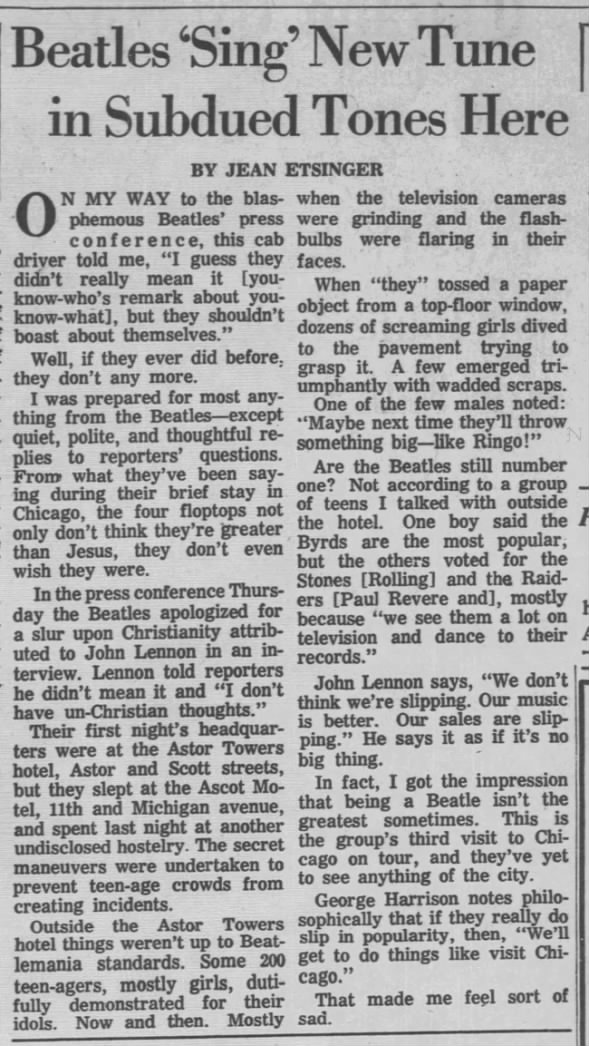
“Beatles ‘Sing’ New Tune in Subdued Tones Here”
No one blinked when John Lennon commented on Christianity in the London Evening Standard months earlier. But by the time Beatles arrived in Chicago on Aug. 11, 1966, to launch what would be their last U.S. concert tour, the line about the band being “more popular than Jesus” had put the Fab Four in the crosshairs of that era’s version of cancel culture.
So, the stakes were high when Lennon, Paul McCartney, George Harrison and Ringo Starr addressed the media on the 27th floor of the Astor Tower Hotel to try to stem the controversy.
“I wasn’t saying that the Beatles were better than God or Jesus or Christianity,” Lennon said, as quoted on page 3 of the next day’s Chicago Tribune. “I could have said TV or cinema or motor cars are bigger than Jesus.”
An Alabama DJ who had seen the remark about Christianity’s declining popularity reprinted in a July issue of a U.S. teen magazine started an anti-Beatles campaign, demanding an apology. The controversy sparked calls for boycotts, record-burning and even death threats. Protesters included the Ku Klux Klan.
“I apologize to him if he wants me to,” Lennon said of the radio personality. “I’m sorry I said it. I’m sorry for the mess it’s made. I never meant it as an anti-religious thing.”
The Tribune ran a longer piece two days after the news conference.
“I was prepared for most anything from the Beatles – except quiet, polite, and thoughtful replies to reporters’ questions,” Jean Etsinger wrote. “From what they’ve been saying during their brief stay in Chicago, the four floptops not only don’t think they’re greater than Jesus, they don’t even wish they were.”
If you watch video clips of the Beatles and the press, you’ll catch one reporter seemingly trying to set a trap by asking Lennon if he felt he was being crucified.
“No,” he said, not taking the bait. “I wouldn’t say that at all.”
The controversy cooled somewhat, though the band faced death threats and protests through the U.S. tour.
In fact, the Jesus remark dogged Lennon one way or another the rest of his life.
Among those reportedly upset by the sentiment, Mark David Chapman, who murdered Lennon outside his New York apartment building in 1980.
—
Calvin Coolidge dedicates Mt. Rushmore as work on monument begins — Aug. 10, 1927
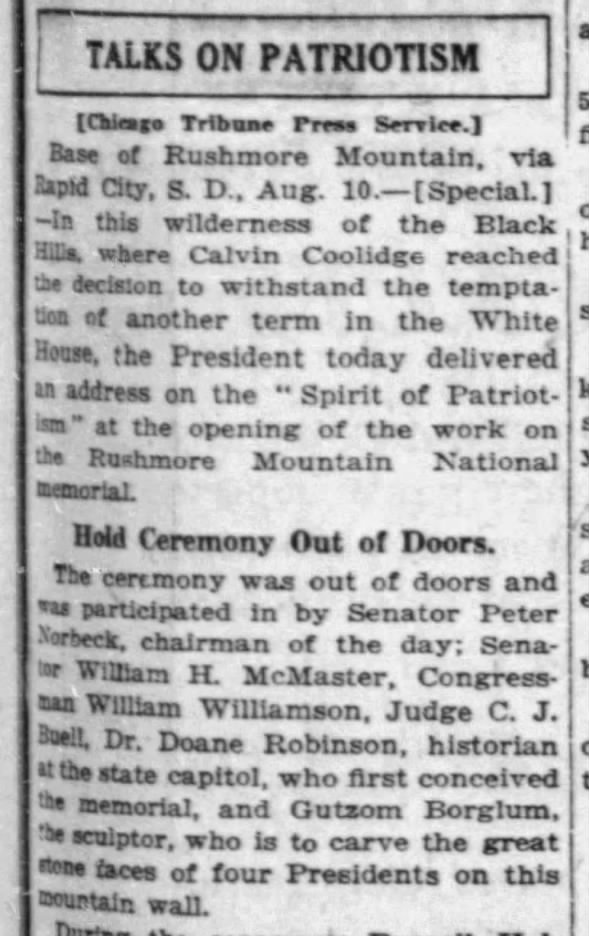
“Talks on Patriotism”
President Calvin Coolidge went to the wilderness of the Black Hills in South Dakota on Aug. 10, 1927, to celebrate the start of work on a monument to be carved into the side of Mount Rushmore.
The 60-foot likenesses of the heads of former Presidents George Washington, Thomas Jefferson, Abraham Lincoln and Theodore Roosevelt would take 14 years to complete on what the Lakota Sioux long called Six Grandfathers.
Coolidge’s dedication was overshadowed at the time by a report he had decided not to run for re-election the following year. (Both those matters in turn were eclipsed on the Chicago Tribune’s front page by a stay of execution for convicted murderer Nicola Sacco of Sacco & Vanzetti notoriety.)
Said the president nicknamed Silent Cal: “Here, in the heart of the continent, on the side of a mountain, which probably no white man had ever beheld in the days of Washington, in territory that was acquired by the action of Jefferson, which remained in almost unbroken wilderness beyond the days of Lincoln, which was especially beloved by Roosevelt, the people of the future will see history and art combined to portray the spirit of patriotism.”
Left unremarked upon was the contentious history of the mountain and land around it, which was granted to the Lakota people in perpetuity in 1868, then wrested back a few years later and remains embroiled in controversy.
The monument at Rushmore was conceived to attract tourists to South Dakota. Recruited for the job was sculptor Gutzon Borglum, who had worked on the huge bas-relief Confederate Memorial Carving in Stone Mountain, Ga., but had a falling out with its organizers.
As part of Coolidge’s ceremony, the Tribune reported, “Borglum went up the 1,400-foot stairway to the mountain top, was swung over the face of the cliff and began the work of outlining the face of the first President.”
Borglum, who directed a crew of hundreds, would die less than eight months before the project was completed in 1941. Son Lincoln Borglum would finish it.
“The progress of America has been due to the spirit of the people,” Coolidge said. “It is in no small degree due to that spirit that we have been able to produce such great leaders. If coming generations are to maintain a like spirit, it will be because they continue to support the principles which these men represented. It is for that purpose that we erect memorials.”
Manson family murders — Aug. 9, 1969
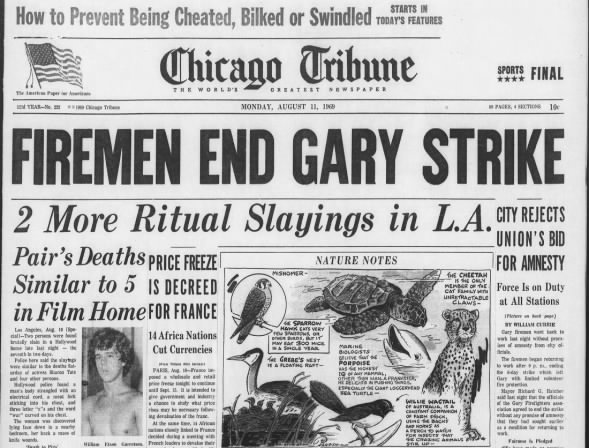
“2 More Ritual Slayings in L.A.: Pair’s Deaths Similar to 5 in Film Home”
Months before Charles Manson became known to the world as evil incarnate, pregnant actress Sharon Tate and four others were found brutally slain in her Los Angeles home on Aug. 9, 1969, with the word “PIG” smeared on the door with her blood.
Two more Los Angelenos – supermarket executive Leno LaBianca and his wife, Rosemary – would be killed within the next 24 hours in similarly ghoulish fashion.
On the LaBianca’s wall and door were smeared “Death to pigs” and “Rise” in blood. On their refrigerator door was “Healter Skelter,” a botched spelling of the Beatles song “Helter Skelter,” which Manson interpreted as heralding a race war.
Details beyond the human toll and the ugliness of the crimes were fuzzy initially and investigators, too, were struggling to make sense of the horror.
In some ways, people still are. Such is fascination with the gruesome details that they have been told and retold in non-fiction and fiction across a variety of media over the last half-century.
Suffice it to say, it took months to tie the ritualistic Tate-LaBianca murders and other crimes to Manson and members of his counterculture cult. The trial began June 15, 1970.
Manson, who sent the killers to Tate’s home but did not go himself, and four other members of his so-called family were sentenced to death in early 1971, only to have the California death penalty ruled unconstitutional in 1972.
Only three of those five remain alive and behind bars. Manson died in 2017 at age 83.
Fascination with the Manson, his adherents and the horrific Tate-LaBianca murders will outlive them all.
Nixon announces resignation — Aug. 8, 1974

“Nixon resigns”
Twenty-one months after winning a second term by one of the largest margins in history, President Richard Nixon addressed the nation from the Oval Office on Aug. 8, 1974, to announce he was resigning from the high office.
Nixon stepped down to avoid impeachment for his role in the Watergate scandal, which he said was tying up the government. He admitted no guilt and said he would have preferred to remain in office, but he asserted he was acting “in the best interests of the country.”
Vice President Gerald Ford was to be sworn in as the 38th president of the United States the next day. He later pardoned Nixon, which played a role in losing his reelection bid to Jimmy Carter in 1976.
By the time Nixon capitulated, the scandal stemming from the break-in into Democratic National Committee headquarters at the Watergate complex and the subsequent cover-up effort had cast a dark cloud on the White House.
Support for Nixon eroded on Capitol Hill from Republicans as well as Democrats. Impeachment was a certainty, ouster from office likely.
“More than two dozen government officials, including Nixon’s closest friends and advisers, were implicated in the scandal,” Chicago Tribune correspondents Frank Starr and Aldo Beckman reported. “Forty-six individuals and 13 corporations have been indicted, convicted, or have pleaded guilty on criminal charges connected with it.”
The resignation speech came six years to the day from Nixon’s acceptance of the GOP nomination for president in Miami, which marked a rebound from humbling losses for president in 1960 and Governor of California in 1962.
After the California loss, Nixon famously vented in what he said would be his “last press conference,” telling reporters they wouldn’t “have Dick Nixon to kick around anymore.”
Nixon sounded less embittered a dozen years later in his farewell speech to White House staff the day after his national address.
“Never get discouraged,” Nixon said. “Never be petty. Always remember others may hate you. Those who hate you don’t win unless you hate them. And then you destroy yourself.”
Philippe Petit walks a tightrope between World Trade Center towers — Aug. 7, 1974

“Wirewalker dazzles crowd; judge orders a lofty bow”
The idea that had him dancing on a wire suspended between the tops of New York’s World Trade Center Twin Towers without a net on the morning of Aug. 7, 1974, came to Philippe Petit eight years earlier in his Paris dentist’s waiting room.
The Frenchman’s stunt proved one of the most memorable events in the ill-fated history of the Manhattan landmarks.
Petit was waiting to have a toothache examined when he saw a newspaper with a rendering of the dual skyscrapers then under construction and set to be the world’s tallest buildings. For the street performer, then 18, it was a vision.
He surreptitiously pocketed the clipping, then set about honing his skills. Petit walked a wire between the two towers of Paris’ Notre Dame Cathedral in 1971. Two years later, he pulled off a similar stunt involving Australia’s Sydney Harbour Bridge.
Each time he risked more than merely life and limb. Because he didn’t seek permission, these performances were criminal acts, a modus operandi that didn’t change in New York.
By 1974, Chicago’s Sears Tower had overtaken the towers as the world’s tallest building, but the dream of walking 1,350 feet up was not diminished.
“If I die, what a beautiful death!” Petit said in the 2008 documentary, “Man on Wire.”
Petit and the friends he lined up to help him donned many guises to gather reconnaissance on the WTC buildings, which were open but not yet completed.
Early on Aug. 7, Petit and his co-conspirators strung up their wire between the buildings, and he walked out into the void between 7 and 7:30 a.m., dazzling office workers en route to their jobs below.
Police awaited on either side as he paced back and forth and put on his show, though he wound up sentenced only to perform a show for children in Central Park.
“I saw him do his dancing routine for 40 minutes,” Port Authority Sgt. Charles Daniels said in the Tribune. “He was laughing and smiling to himself. He had complete confidence in his ability. He lay down on the high wire and started rolling around lackadaisically. He would just lie there as if he wanted a take a nap.”
It turned out the stunt unexpectedly endeared people to what had been seen as cold, impersonal additions to the city skyline and Petit lovingly referred to them as “my towers” until terrorists brought them down in 2001.
Now he calls them “our towers.”
US drops atomic bomb on Hiroshima — Aug. 6, 1945
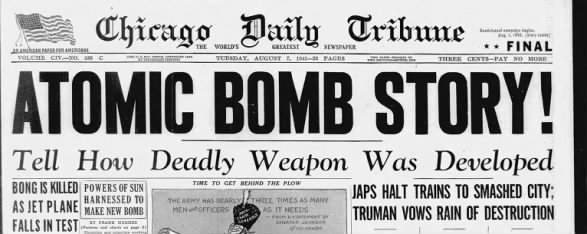
“Atomic Bomb Story!”
There is a clear historic line for mankind before and after Aug. 6. 1945, and the story of the United States dropping the first atomic weapon on the Japanese city of Hiroshima that day is written in shorthand in some of the front-page headlines in the next morning’s Chicago Tribune.
“Atomic Bomb Story!”
“Japs Halt Trains to Smashed City; Truman Vows Rain of Distruction.”
“Power of Universe Tapped to Create New Missile.”
“Tense Truman Bares Secret.”
“Billowing Fire Ball Dims Sun in Desert Test.”
“5,000 Scientists at U. of C. Worked 3 Years on Bomb.”
Those are broad strokes, anyway.
Details such as the fact 80,000 civilians were instantly killed – and tens of thousands more would perish later from radiation exposure – weren’t immediately known.
Debates over the morality and long-term ramifications of President Harry Truman’s decision to introduce weapons of mass destruction would come later.
There was at the time a tortuous, dehumanizing war in the Pacific still to be won, avenging the unprovoked attack on Pearl Harbor that brought the United States into World War II almost four years earlier.
“An epochal announcement of a new secret weapon, foreshadowing an early end of the war with Japan, was made today by President Truman,” Tribune correspondent Arthur Sears Henning wrote from Washington, D.C. “The weapon is an atomic bomb, a projectile which looses the colossal energy of the atom with an explosive force 20,000 tons greater than TNT.”
This and the second bomb dropped three days later on Nagasaki were the product of years of top-secret research at the University of Chicago, in the New Mexico desert and elsewhere.
At first it was a race to beat the Nazis who had been trying to develop their own mega-bomb before Germany and the Axis powers surrendered months earlier. In the end it was to avoid the casualties of a ground war to take Tokyo and other Japanese cities.
The atom bombs did in fact bring an end to those costly conflicts.
But it ignited the Cold War, an arms race and the pervasive fear some nation or terrorist would someday avail itself of that same awful power in all-too-imaginable ways.
From that day on, the end of the world was a possibility.
—
The first draft of Chicago history at your fingertips. Not just news but obituaries, social pages, sports and some very amusing old-school advertisements at newspapers.com
The death of Marilyn Monroe — Aug. 5, 1962
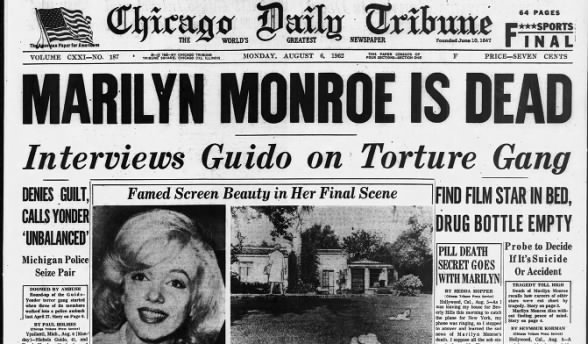
“Marilyn Monroe is Dead”
“Goodbye Norma Jeane, though I never knew you at all, you had the grace to hold yourself while those around you crawled,” Elton John sang years later in “Candle in the Wind,” a bittersweet remembrance of Marilyn Monroe, who remains an alluring Hollywood archetype decades after her last film.
Monroe, whose birth name was Norma Jeane Mortenson, was found dead of a barbiturate overdose in her home in the posh Brentwood area of Los Angeles on Aug. 5, 1962.
She was just 36, leaving her forever young and tragic in the collective consciousness.
Monroe had been a top star for years in movies such as “Gentlemen Prefer Blondes,” “The Seven Year Itch,” “Bus Stop,” “The Prince and the Showgirl,” “How to Marry a Millionaire” and “Some Like It Hot.”
Sometimes overlooked by those her appeal dazzled were acting chops she honed at the Actors Studio and with other leading instructors.
Her death would be ruled a probable suicide by the L.A. County coroner. But to this day some still surmise Monroe fell victim of something sinister, pointing to relationships and secrets she may have shared with powerful men such as President John F. Kennedy.
Much of the first-day reporting of her death was awash in the sexism of the day.
“It was known that the scar of her illegitimate birth, her three broken marriages, and her inability to bear children had tortured Marilyn (through) the years,” Tribune correspondent Seymour Korman wrote, asserting Monroe battled insecurities her whole career.
Later, Korman noted, “Marilyn’s body, whose superb measurements had delighted so many filmgoers and viewers of calendar art, was covered by a pale blue blanket and strapped to a stretcher.”
Such was Monroe’s appeal that when Chicago’s Hugh Hefner was launching Playboy magazine in 1953 with $8,000 he borrowed from family, he spent $500 to publish an old calendar photo of Monroe for which she had posed nude before her film career took off. It helped ensure the first issue was a hit.
The two never met, but Hefner, who died in 2017, spent $75,000 in 1992 so he could be interred in the crypt next to the star.
For years, former Yankees outfielder Joe DiMaggio – an ex-husband of Monroe’s – paid to regularly stock Monroe’s crypt with fresh roses.
Another former spouse was Arthur Miller, playwright of “Death of a Salesman,” “All My Sons” and “The Crucible.” Just a few years after Monroe’s death, he included a self-destructive (and suicidal) Marilyn-esque character in his play, “After the Fall,” which was meant to be an exploration of his own psyche but was interpreted by some as a final betrayal of his late ex.
“In a way, we’re all guilty,” Hedda Hopper wrote in a front-page Tribune column on Monroe’s death. “We loved her and left her lonely and afraid when she needed us the most.”
Hans Christian Andersen dies — Aug. 4, 1875
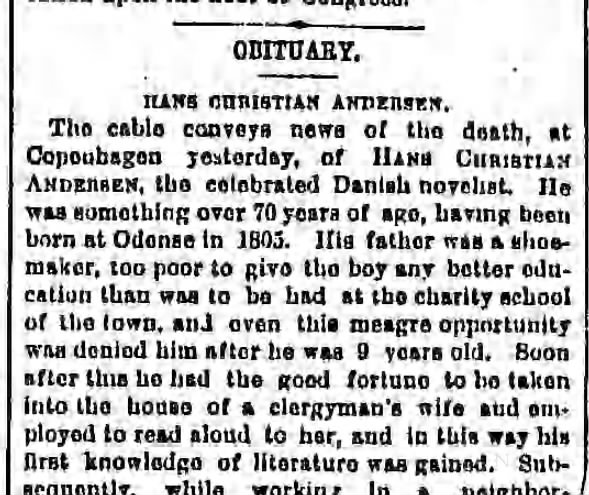
“Hans Christian Andersen”
Hans Christian Andersen was as much a part of our childhoods as the princess who slept fitfully because of a pea tucked between her mattresses, the vain emperor who was conned into believing his birthday suit was high fashion and the ugly duckling who was in fact a swan.
Andersen, who lives on through the children’s stories he wrote, died in Copenhagen on Aug. 4, 1875.
While the next morning’s Tribune dutifully noted Andersen’s passing at age 70, the obituary curiously made no mention of the Danish author’s most enduring works.
Besides “The Princess and the Pea,” “The Emperor’s New Clothes” and “The Ugly Duckling,” these stories included “The Little Mermaid,” “Thumbelina,” “The Little Match Girl,” “The Red Shoes” and “The Snow Queen.”
The paper did recount Andersen’s rise from humble beginnings, early difficulties getting his career on track – it turned out tragedies for adults were not his métier – and how he ultimately triumphed.
“His charming tales,” the obit reported, had “been translated into English, German, French, Dutch and even Russian.”
Their global reach today is even greater, including adaptations in film, television, opera, the ballet and stage. His works are one of Denmark’s best known exports.
Andersen’s stories sometimes were based on folklore or riffs on the work of others. But others were inspired by events in his life.
“The Red Shoes” developed from the memory of an unsatisfied customer of his shoemaker father and Andersen is said to have intimated “The Ugly Duckling” was somewhat autobiographical in that he felt an outcast until later in life.
And in some of his tales, there remained occasional elements of tragedy, such as the mermaid reduced to sea foam and the match girl who freezes to death, though both those characters eventually found salvation in the afterlife.
Andersen’s memory today is honored in Copenhagen through a statue and H. C. Andersens Boulevard, a busy six-lane throroughfare near City Hall – no doubt perfectly suited for a parade should some egotistical leader want to show off his fanciest duds.
The NBL and BAA merge to form the NBA — Aug. 3, 1949

“Pro Basketball Leagues Merge”
For reasons that aren’t entirely clear, the NBA these days casts the blending of the two leagues under a singular new name – the culmination of a three-year effort to ensure the competing pro basketball leagues didn’t drive each other out of business – as an expansion of the BAA, just three years old when it joined forces with the then-12 NBL.
Today’s NBA doesn’t even acknowledge the stand-alone records of the NBL, preferring to claim the 1946-47 season that launched the BAA as its first.
Out of the 17 teams the NBA debuted with in 1949-50, however, only eight made it to 1954-55 and are still around today and it’s that scrappy core from which today’s pro basketball is rooted.
Five of those eight franchises began with the NBL. Only three — the Boston Celtics, New York Knicks and Philadelphia Warriors, now Golden State — originated in the BAA.
Admittedly, three of the five enduring NBL teams jumped to the BAA in 1948, a year ahead of the merger.
The Minneapolis Lakers now call Los Angeles home. The Rochester (N.Y.) Royals are now the Sacramento Kings. The Fort Wayne (Ind.) Pistons wound up in Detroit.
It took the formal combination of the rival leagues to bring into the fold the NBL’s Tri-Cities Black Hawks (from Moline, Ill.; Rock Island, Ill.; and Davenport, Iowa) that now are the Atlanta Hawks and the Syracuse (N.Y.) Nationals that morphed into the Philadelphia 76ers.
Snuffed out in the first five seasons were the Chicago Stags along with teams in Washington, D.C.; St. Louis; Baltimore, Indianapolis; Denver; Anderson Ind.; Sheboygan, Wis., and Waterloo, Iowa.
There was a mention of a potential Milwaukee team in the initial report on the merger that appeared in the Tribune. But it didn’t make it to the NBA’s opening day, vanishing like the NBL in today’s NBA record books.
Black Sox acquitted — Aug. 2, 1921

“Jury Frees Baseball Men”
It took a Chicago jury only 2 hours and 47 minutes on Aug. 2, 1921, to acquit the so-called Black Sox baseball players, who had been accused of conspiring with gamblers to throw the 1919 World Series as members of the White Sox.
Pitcher Eddie Cicotte jumped up and slapped teammate “Shoeless” Joe Jackson on the back, then made a beeline to shake the jury foreman’s hand.
“Thanks,” Cicotte told him, “I knew you’d do it.”
The verdict, read before Cook County Circuit Court Judge Hugo Friend at 11:22 p.m., cleared Cicotte, Jackson, “Buck” Weaver, “Chick” Gandil, “Swede” Risberg, “Happy Felsch,” “Lefty” Williams and Fred McMullin, overshadowing news of Italian opera great Enrico Caruso’s death at 48.
“Everybody knew I had nothing to do with the conspiracy,” said Weaver, who batted .324 in the Series vs. the Cincinnati Reds. “I believe that I should be given my old position back. I’m going to fight for it.”
Weaver’s hopes would be dashed the following day.
Kenesaw Mountain Landis, installed as all-powerful commissioner of baseball in response to the gambling scandal, banned the players anyway because they didn’t immediately report that a fix was even under discussion. The ruling holds today, long past all their deaths, despite occasional efforts to restore the good name for some of the outcasts.
Modern impressions of what transpired roughly a century ago are shaped largely by an apocryphal quote (“Say it ain’t so, Joe”) and “Eight Men Out,” a slightly fictionalized 1963 book by Eliot Asinof that was the basis for a 1988 film.
Contemporary Tribune coverage noted rumors had swirled regarding a rigged Series while the best-of-nine faceoff was underway and suggested the prospect of harsh punishment from Landis wasn’t entirely unexpected.
But the scandal-scarred ballplayers didn’t allow that possibility to eclipse the euphoria of being declared innocent.
“Never was in doubt about the verdict,” Gandil said. “I knew where I stood and knew I had done no wrong. I’m going to try to get hold of a good ball club and manage it.”
Thirty-five years later, however, Gandil would cop to his role. “I was a ringleader,” he told Sports Illustrated in 1956.
MTV debuts — Aug. 1, 1981

“New shock in rock: Stereo, video locked into TV” by Marilyn Preston
“Starting right now, you’ll never look at music the same way again,” Mark Goodman told viewers as MTV Music Television – “the world’s first 24-hour stereo music video channel” – made its debut at 12:01 a.m. ET on August 1, 1981.
The embryonic channel would within a few years broaden its ambitions – and, notably, its playlist – to become a cultural force, reshaping culture and commerce.
But at launch it only was available in 1.5 million to 2 million homes nationally. And in the Chicago area, where relatively few communities were wired for cable, only households in Elgin, Joliet and Romeoville had the channel.
Presiding over programming was Robert Pittman, who, seven years earlier as a 20-year-old radio wiz kid, famously led a revival of Chicago’s WMAQ-AM, which soared from 22nd in the market to No. 3 in three months, buoyed by country music and a heavily hyped “WMAQ is gonna make me rich!” cash contest.
The Chicago Tribune didn’t weigh in on Pittman’s MTV handiwork until 10 days after its launch.
Columnist Marilyn Preston misidentified MTV and didn’t quite anticipate the seismic impact that would stem from actually capturing its elusive target audience of viewers age 12 to 34. (She also referred to the Thompson Twins as “the Tampion Twins.)
But, to be fair, she also hadn’t actually seen the channel yet.
“I’ve only seen the 14-minute demo tape, but clearly the Music Channel is the brainless wave of the future,” Preston wrote.
The Buggles’ “Video Killed the Radio Star” immediately became a trivia answer as MTV’s first music video.
Less well-known is that Hans Zimmer, who would become famous as a composer of more than 150 film scores, can be seen briefly on keyboards.
—
The first draft of Chicago history at your fingertips. Not just news but obituaries, social pages, sports and some very amusing old-school advertisements at newspapers.com

